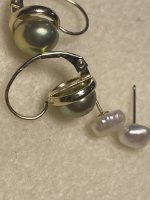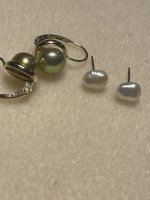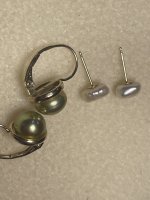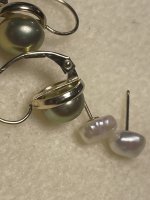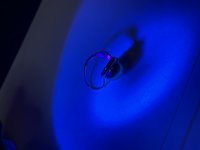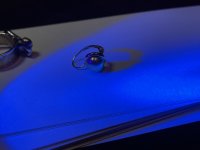S
You are using an out of date browser. It may not display this or other websites correctly.
You should upgrade or use an alternative browser.
You should upgrade or use an alternative browser.
Pearl Dreams
Pearl Enthusiast
- Joined
- Sep 24, 2007
- Messages
- 9,893
What color is the background material? That is, do the photos show the pearl color accurately?
How do you know the colored pearls are not color treated? Pistachio colored Tahitians, if that is what they are, are known to sometimes be color treated.
Edited to add reference: https://www.gia.edu/gems-gemology/s...lored-pearls-treated-ballerina-pearl-company?
Next: are you sure the leverback earring pearls are real? I ask because a nice gem shop I used to frequent (now closed) had a bunch of pearls they had marked as real pearls but they were definitely imitation. Some were greenish. After I showed them how I knew they were imitation, they had their vendor take them all back.
• How closely do the colors and dimensions of the 2 greenish button pearls match each other? Too uniform to be true?
• Do they pass the tooth test? When you examine the surface with a 10x loupe, is it smooth looking as real nacre should be? Or a bit coarse like imitation pearl coating looks under 10x magnification?
The white studs are likely cultured FW keshi; I have seen such pearls sold on gold posts at a pricey shop in CT. Absent proof to the contrary, I would assume they are FW (as opposed to SS keshi).
How do you know the colored pearls are not color treated? Pistachio colored Tahitians, if that is what they are, are known to sometimes be color treated.
Edited to add reference: https://www.gia.edu/gems-gemology/s...lored-pearls-treated-ballerina-pearl-company?
Next: are you sure the leverback earring pearls are real? I ask because a nice gem shop I used to frequent (now closed) had a bunch of pearls they had marked as real pearls but they were definitely imitation. Some were greenish. After I showed them how I knew they were imitation, they had their vendor take them all back.
• How closely do the colors and dimensions of the 2 greenish button pearls match each other? Too uniform to be true?
• Do they pass the tooth test? When you examine the surface with a 10x loupe, is it smooth looking as real nacre should be? Or a bit coarse like imitation pearl coating looks under 10x magnification?
The white studs are likely cultured FW keshi; I have seen such pearls sold on gold posts at a pricey shop in CT. Absent proof to the contrary, I would assume they are FW (as opposed to SS keshi).
Last edited:
Pearl Dreams
Pearl Enthusiast
- Joined
- Sep 24, 2007
- Messages
- 9,893
I'm going to blather on a bit now with some observations.
Unless pre-owned jewelry comes with expert documentation, it's wise to be a bit skeptical about what it is or isn't.
Real vs. imitation, color treated vs. not treated, type of pearl, or any other gem. Glass and synthetic gems are put into valuable settings.
I have imitation pearls with 18K clasps.
I inherited 18K and 14K-set "aquamarines" from my grandmother that proved to be glass and synthetic spinel, respectively.
Here's another example: Let's say I go to an estate sale or auction and there I see a strand of pearls that the person running the sale states are South Sea pearls, but they don't have the original bill of sale or expert documentation from an appraiser. Are they or aren't they SSP, vs. FWP or akoya? (Or, for that matter, imitation?) I would not just take the word of the seller on that. Everyone wants their pearls to be the most valuable kind; often they are not.
Or say I buy a strand secondhand from a private seller on eBay, or at a tag sale, or Loupe Troop, who bought it herself previously from a seller who swore they were SSP? Are they SSP? Maybe not. Maybe the previous seller was sincerely (or fraudulently) wrong about what they were selling. Thus a mistake gets repeated, over and over each time they are resold.
Once I bought a strand of pearls at TJ Maxx that were marked, on the attached tag, as genuine pearls/14K clasp. I took them home and louped them. Not only were they imitation, but the clasp was base metal too! Back they went.
Another time I bought a large ringed strand -- (again, T. J. Maxx) marked as genuine FW pearls. At home I checked them closer. Fake! Back they went.
Now I always carry a loupe with me.
I've been told by jewelers that I know more about pearls than they do. Most jewelers don't know much about pearls. They trust their vendors.
Unless pre-owned jewelry comes with expert documentation, it's wise to be a bit skeptical about what it is or isn't.
Real vs. imitation, color treated vs. not treated, type of pearl, or any other gem. Glass and synthetic gems are put into valuable settings.
I have imitation pearls with 18K clasps.
I inherited 18K and 14K-set "aquamarines" from my grandmother that proved to be glass and synthetic spinel, respectively.
Here's another example: Let's say I go to an estate sale or auction and there I see a strand of pearls that the person running the sale states are South Sea pearls, but they don't have the original bill of sale or expert documentation from an appraiser. Are they or aren't they SSP, vs. FWP or akoya? (Or, for that matter, imitation?) I would not just take the word of the seller on that. Everyone wants their pearls to be the most valuable kind; often they are not.
Or say I buy a strand secondhand from a private seller on eBay, or at a tag sale, or Loupe Troop, who bought it herself previously from a seller who swore they were SSP? Are they SSP? Maybe not. Maybe the previous seller was sincerely (or fraudulently) wrong about what they were selling. Thus a mistake gets repeated, over and over each time they are resold.
Once I bought a strand of pearls at TJ Maxx that were marked, on the attached tag, as genuine pearls/14K clasp. I took them home and louped them. Not only were they imitation, but the clasp was base metal too! Back they went.
Another time I bought a large ringed strand -- (again, T. J. Maxx) marked as genuine FW pearls. At home I checked them closer. Fake! Back they went.
Now I always carry a loupe with me.
I've been told by jewelers that I know more about pearls than they do. Most jewelers don't know much about pearls. They trust their vendors.
S
Supernova
Guest
This is where being a gemologist comes in handy I am not questioning their authenticity. Just type.
S
Supernova
Guest
This is where being a gemologist comes in handy I am not questioning their authenticity. Just type. Also I buy from very wealthy people….. not vendors or re sellers
S
Supernova
Guest
Why I’m a gemologist not a jewelerI'm going to blather on a bit now with some observations.
Unless pre-owned jewelry comes with expert documentation, it's wise to be a bit skeptical about what it is or isn't.
Real vs. imitation, color treated vs. not treated, type of pearl, or any other gem. Glass and synthetic gems are put into valuable settings.
I have imitation pearls with 18K clasps.
I inherited 18K and 14K-set "aquamarines" from my grandmother that proved to be glass and synthetic spinel, respectively.
Here's another example: Let's say I go to an estate sale or auction and there I see a strand of pearls that the person running the sale states are South Sea pearls, but they don't have the original bill of sale or expert documentation from an appraiser. Are they or aren't they SSP, vs. FWP or akoya? (Or, for that matter, imitation?) I would not just take the word of the seller on that. Everyone wants their pearls to be the most valuable kind; often they are not.
Or say I buy a strand secondhand from a private seller on eBay, or at a tag sale, or Loupe Troop, who bought it herself previously from a seller who swore they were SSP? Are they SSP? Maybe not. Maybe the previous seller was sincerely (or fraudulently) wrong about what they were selling. Thus a mistake gets repeated, over and over each time they are resold.
Once I bought a strand of pearls at TJ Maxx that were marked, on the attached tag, as genuine pearls/14K clasp. I took them home and louped them. Not only were they imitation, but the clasp was base metal too! Back they went.
Another time I bought a large ringed strand -- (again, T. J. Maxx) marked as genuine FW pearls. At home I checked them closer. Fake! Back they went.
Now I always carry a loupe with me.
I've been told by jewelers that I know more about pearls than they do. Most jewelers don't know much about pearls. They trust their vendors.
Pearl Dreams
Pearl Enthusiast
- Joined
- Sep 24, 2007
- Messages
- 9,893
I was just chatting with my husband about this whole topic and he asked me how I could be sure that pearls I buy are not color treated?
I told him that the best way to be sure is to buy from a vendor who is careful about their own sources.
e.g. Golden SSP can be color treated in a way that one cannot be sure just by looking at them that they have been color treated. This is more likely to be the case if the color is a deep gold (the most valuable color.) So I'm really picky about my sellers. I know the people I buy from are picky about their suppliers.
re: Pistachio Tahitians, do read the GIA article. I would bet that some folks have unknowingly bought pistachio colored pearls that were color treated, from stores that unknowingly sold them. And wealthy people are not immune.
Bottom line, I'd be careful about listing pistachio pearls as not being color treated, since you really cannot know.
I told him that the best way to be sure is to buy from a vendor who is careful about their own sources.
e.g. Golden SSP can be color treated in a way that one cannot be sure just by looking at them that they have been color treated. This is more likely to be the case if the color is a deep gold (the most valuable color.) So I'm really picky about my sellers. I know the people I buy from are picky about their suppliers.
re: Pistachio Tahitians, do read the GIA article. I would bet that some folks have unknowingly bought pistachio colored pearls that were color treated, from stores that unknowingly sold them. And wealthy people are not immune.
Bottom line, I'd be careful about listing pistachio pearls as not being color treated, since you really cannot know.
Pearl Dreams
Pearl Enthusiast
- Joined
- Sep 24, 2007
- Messages
- 9,893
Most people who read this thread will not be gemologists; I write with them also in mind.Why I’m a gemologist not a jeweler
Many who read this thread buy pearls and other jewels on eBay; my words are also for them.
Pearl Dreams
Pearl Enthusiast
- Joined
- Sep 24, 2007
- Messages
- 9,893
Just want to add I think it's great that we have this forum where people can come and check out what they have bought, or are thinking of buying, or selling. Better to do it before than after. 
S
Supernova
Guest
I can sense artificial coloration plus my teacher certain of that…. Takes schooling to be able to discern on a higher level.
So the white pearls are?
So the white pearls are?
Attachments
-
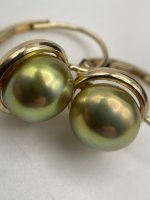 IMG_3537.jpeg1,012 KB · Views: 169
IMG_3537.jpeg1,012 KB · Views: 169 -
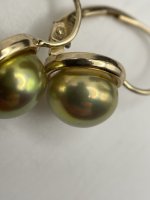 IMG_3538.jpeg948.6 KB · Views: 170
IMG_3538.jpeg948.6 KB · Views: 170 -
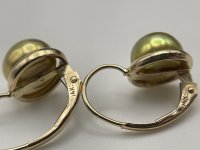 IMG_3539.jpeg1.4 MB · Views: 164
IMG_3539.jpeg1.4 MB · Views: 164 -
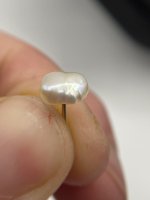 IMG_3540.jpeg909.9 KB · Views: 173
IMG_3540.jpeg909.9 KB · Views: 173 -
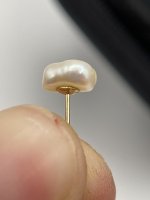 IMG_3541.jpeg917.2 KB · Views: 200
IMG_3541.jpeg917.2 KB · Views: 200 -
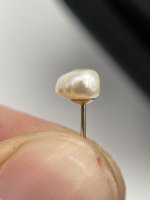 IMG_3542.jpeg984.9 KB · Views: 165
IMG_3542.jpeg984.9 KB · Views: 165 -
 IMG_3543.jpeg954.9 KB · Views: 151
IMG_3543.jpeg954.9 KB · Views: 151 -
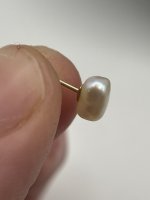 IMG_3544.jpeg954.9 KB · Views: 196
IMG_3544.jpeg954.9 KB · Views: 196 -
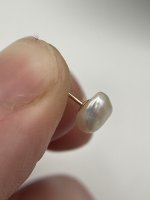 IMG_3547.jpeg936 KB · Views: 183
IMG_3547.jpeg936 KB · Views: 183 -
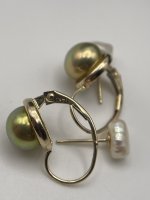 IMG_3549.jpeg1 MB · Views: 149
IMG_3549.jpeg1 MB · Views: 149
S
Supernova
Guest
Non gemologist should seek gemologistMost people who read this thread will not be gemologists; I write with them also in mind.
Many who read this thread buy pearls and other jewels on eBay; my words are also for them.
Pearl Dreams
Pearl Enthusiast
- Joined
- Sep 24, 2007
- Messages
- 9,893
Not all gemologists are pearl experts, either. Expertise comes with lots and lots of experience. Just saying.
Thanks for the extra photos.
So my opinion, such as it is, is that you likely have:
1. FW keshi studs (very pretty)
and
2. Pistachio Tahitians that may or may not have been color enhanced (see GIA article).
I'll be very interested to read what Jeremy and Douglas have to say, and would defer to their judgment. I don't consider myself to be an expert, by the way. Just well-read.
Thanks for the extra photos.
So my opinion, such as it is, is that you likely have:
1. FW keshi studs (very pretty)
and
2. Pistachio Tahitians that may or may not have been color enhanced (see GIA article).
I'll be very interested to read what Jeremy and Douglas have to say, and would defer to their judgment. I don't consider myself to be an expert, by the way. Just well-read.
jshepherd
Pearl Paradise
- Joined
- Jun 22, 2004
- Messages
- 6,344
I don't think there are any pearl experts who can sense color treatment. It's something you either recognize from signs of treatment, or test for to be definitive. If you're sensing for it, please don't resell them that way.
Gemologists tend to know very little about pearls. Courses are geared toward diamonds and colored stones, but very little goes into pearls. Because there are no internationally recognized standards, the only way to become an expert in pearls is through experience. There are very few pearl experts around, and many of them are not gemologists because they specialize in pearls. Gemologists often come here to learn about pearls, but very few are pearl experts.
The white studs appear to be freshwater on studs. The greenish pearls are questionable. I can't tell definitively from the photo whether one is a flattened button and the other is more rounded. I can tell by the size that they are not Tahitian, and the color is not Tahitian. It's similar to pistachio or a pastel Fijian, but isn't. I have seen natural-color freshwater buttons in this color, but it's not common and they typically have more secondary colors when they go into "strange color" or exotic.
Gemologists tend to know very little about pearls. Courses are geared toward diamonds and colored stones, but very little goes into pearls. Because there are no internationally recognized standards, the only way to become an expert in pearls is through experience. There are very few pearl experts around, and many of them are not gemologists because they specialize in pearls. Gemologists often come here to learn about pearls, but very few are pearl experts.
The white studs appear to be freshwater on studs. The greenish pearls are questionable. I can't tell definitively from the photo whether one is a flattened button and the other is more rounded. I can tell by the size that they are not Tahitian, and the color is not Tahitian. It's similar to pistachio or a pastel Fijian, but isn't. I have seen natural-color freshwater buttons in this color, but it's not common and they typically have more secondary colors when they go into "strange color" or exotic.
S
Supernova
Guest
My thought was FW due to shape, also. “Sense” it is more a visual sense but I don’t care to elaborate.I don't think there are any pearl experts who can sense color treatment. It's something you either recognize from signs of treatment, or test for to be definitive. If you're sensing for it, please don't resell them that way.
Gemologists tend to know very little about pearls. Courses are geared toward diamonds and colored stones, but very little goes into pearls. Because there are no internationally recognized standards, the only way to become an expert in pearls is through experience. There are very few pearl experts around, and many of them are not gemologists because they specialize in pearls. Gemologists often come here to learn about pearls, but very few are pearl experts.
The white studs appear to be freshwater on studs. The greenish pearls are questionable. I can't tell definitively from the photo whether one is a flattened button and the other is more rounded. I can tell by the size that they are not Tahitian, and the color is not Tahitian. It's similar to pistachio or a pastel Fijian, but isn't. I have seen natural-color freshwater buttons in this color, but it's not common and they typically have more secondary colors when they go into "strange color" or exotic.
CortezPearls
PG Forum Admin
- Joined
- Aug 26, 2005
- Messages
- 4,079
I agree.I'm going to blather on a bit now with some observations.
Unless pre-owned jewelry comes with expert documentation, it's wise to be a bit skeptical about what it is or isn't.
Real vs. imitation, color treated vs. not treated, type of pearl, or any other gem. Glass and synthetic gems are put into valuable settings.
I have imitation pearls with 18K clasps.
I inherited 18K and 14K-set "aquamarines" from my grandmother that proved to be glass and synthetic spinel, respectively.
Here's another example: Let's say I go to an estate sale or auction and there I see a strand of pearls that the person running the sale states are South Sea pearls, but they don't have the original bill of sale or expert documentation from an appraiser. Are they or aren't they SSP, vs. FWP or akoya? (Or, for that matter, imitation?) I would not just take the word of the seller on that. Everyone wants their pearls to be the most valuable kind; often they are not.
Or say I buy a strand secondhand from a private seller on eBay, or at a tag sale, or Loupe Troop, who bought it herself previously from a seller who swore they were SSP? Are they SSP? Maybe not. Maybe the previous seller was sincerely (or fraudulently) wrong about what they were selling. Thus a mistake gets repeated, over and over each time they are resold.
Once I bought a strand of pearls at TJ Maxx that were marked, on the attached tag, as genuine pearls/14K clasp. I took them home and louped them. Not only were they imitation, but the clasp was base metal too! Back they went.
Another time I bought a large ringed strand -- (again, T. J. Maxx) marked as genuine FW pearls. At home I checked them closer. Fake! Back they went.
Now I always carry a loupe with me.
I've been told by jewelers that I know more about pearls than they do. Most jewelers don't know much about pearls. They trust their vendors.
And besides a loupe I always carry a UV lamp. Gives instant feedback!
CortezPearls
PG Forum Admin
- Joined
- Aug 26, 2005
- Messages
- 4,079
The whites look like freshwater pearls to me. They got all the vibes (actually "looks").I can sense artificial coloration plus my teacher certain of that…. Takes schooling to be able to discern on a higher level.
So the white pearls are?
Now, the green colored studs...those are very Cortez pearl like, but Cortez are so rare! Also the Cook Island Pistachios from the 1990's had that color...but I would use my UV lamp to see if they fluoresce red (for Cortez)...and if not I would say very likely color treated freshwaters: they have the polished look of nice freshwaters.
Pearl Dreams
Pearl Enthusiast
- Joined
- Sep 24, 2007
- Messages
- 9,893
The finding of the greenish pearls is nothing very special. It seems to me that very special pearls would have been set in a more special setting, perhaps with diamonds.
S
Supernova
Guest
The whites look like freshwater pearls to me. They got all the vibes (actually "looks").
Now, the green colored studs...those are very Cortez pearl like, but Cortez are so rare! Also the Cook Island Pistachios from the 1990's had that color...but I would use my UV lamp to see if they fluoresce red (for Cortez)...and if not I would say very likely color treated freshwaters: they have the polished look of nice freshwaters.
Thank you.The whites look like freshwater pearls to me. They got all the vibes (actually "looks").
Now, the green colored studs...those are very Cortez pearl like, but Cortez are so rare! Also the Cook Island Pistachios from the 1990's had that color...but I would use my UV lamp to see if they fluoresce red (for Cortez)...and if not I would say very likely color treated freshwaters: they have the polished look of nice freshwaters.
I’m going to send a photo as I’ve never seen a Cortez fluoresce.
Are Cortez button shape commonly?
I have one more ring I was wondering about… it looks like a pearl but an awkward one. Almost looks like labradorite but it’s not….
I am selling these items so I do understand if you do not wish to give your knowledge freely.
Attachments
Pearl Dreams
Pearl Enthusiast
- Joined
- Sep 24, 2007
- Messages
- 9,893
I'm not CortezPearls, but I can venture to answer.
Sea of Cortez pearls would fluoresce red.
The other ring looks like a stone, not a pearl. I have no idea what stone!
This is an educational forum and we love to share our knowledge freely! Sellers who are ethical want to know what they are selling, so questions are always welcome!
Sea of Cortez pearls would fluoresce red.
The other ring looks like a stone, not a pearl. I have no idea what stone!
This is an educational forum and we love to share our knowledge freely! Sellers who are ethical want to know what they are selling, so questions are always welcome!
pattye
Pearl Scholar
- Joined
- Dec 26, 2005
- Messages
- 11,541
What a good discussion.
Here's a link that goes way back, showing photos of Cortez Pearls fluorescing HERE
I have dyed green fw pearls from 15 years ago color much like the earrings shown. The gem in the ring I can't identify, sorry. Definitely not a Cortez Pearl. Doesn't look to me like a pearl based on the photo. We here are more than happy to share information and educate each other.
Here's a link that goes way back, showing photos of Cortez Pearls fluorescing HERE
I have dyed green fw pearls from 15 years ago color much like the earrings shown. The gem in the ring I can't identify, sorry. Definitely not a Cortez Pearl. Doesn't look to me like a pearl based on the photo. We here are more than happy to share information and educate each other.
Similar threads
- Replies
- 1
- Views
- 165

